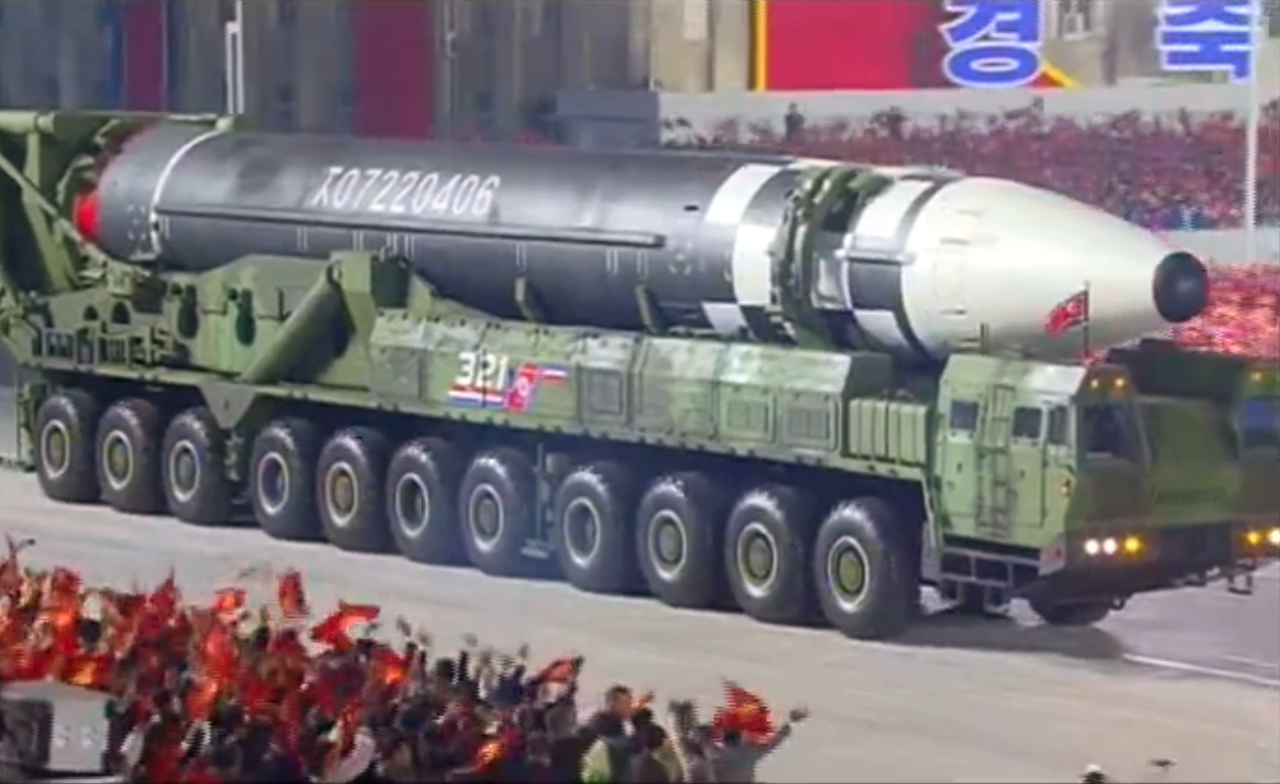Signs Of Multiple Warheads In New North Korean ICBM | 北朝鮮の新型ICBM、複数弾頭の搭載が可能か?

10月10日に平壌で行われた軍事パレードで「新型の大型ICBM」として披露されたミサイルは、これまでのミサイルでは不可能だった複数弾頭の搭載や、より長い射程の実現を意図している可能性がある。
この新型の液体燃料ロケットは、先代となる火星15号の拡大版とみられる。しかし、火星15号は北朝鮮の戦略的意図を実現するには、搭載量・射程ともに不足していた。
パレードの映像を見ると、火星15号と比較したとき、少なくとも2段目ロケットは延長されたように思われる。
2段目の先端に後ろ向きのスロットが確認でき、その形状からすると、ペイロードまたはそのフェアリングを切り離すための小型ロケットが備わっていると考えられる。新型ICBMにフェアリングが存在することで、複数弾頭を搭載できる可能性が高まり、そうであればペイロード量に対してより多くの地域に脅威を与える存在となる。他方、火星15号のペイロードはむき出しの再突入体だった。
このミサイルの試験が行われたとは報じられていない。むしろ、パレードに登場したものはモックアップで、本物のミサイルではない可能性もある。
ただし、このICBMに見られる2段目ロケットの試験が2019年12月に実施されたことを、韓国軍関係者が朝鮮日報紙に対して語っている。このことは、火星15号の2段目ロケットが大型化されていることと符合する。
なお、火星15号は2017年に一度だけ試験されたのみで、その運用価値には大きな疑問符が付いている。
ワシントンの戦略国際問題研究所(CSIS)は火星15号の射程を8,500~13,000kmと推定しており、少なくともアラスカやワシントン州は射程内、そして北朝鮮が主張するとおり、アメリカ全土を射程に収めている可能性もある。
とはいえ、今回の新型ICBMお披露目により、火星15号の推定最長射程は疑わしくなった。より大型のミサイルを開発する以上、その目的が射程の延長にあることは明白だからだ。ただし、射程はそのままで、より多くのペイロードを搭載するための開発ということも考えられる。複数弾頭は単一弾頭と比較して重量がかさむ上、デコイを追加すればさらに重くなるからだ。
朝鮮日報紙は、新型ICBMは2~3個の弾頭を搭載し、全長22~23mと推定している。CSISの推定では、火星15号は全長21~22.5m、直径2~2.4mだ。
一部のメディアは新型ICBMを「火星16号」と呼んでいるが、北朝鮮側は名称を明らかにしていない。ちなみに、火星15号のNATOコードネームはKN-22だ。
この新型ICBMは、11本以上の車軸を備えた、異様な大型の移動式発射器に搭載されて登場した。火星15号の発射器ですら異例の大きさだったが、さらに2本の車軸が追加されている。また、キャブ部分のデザインは異なっている。そして、ミサイルの大型化に伴い、発射器を持ち上げるアームもより前方に移動し、後ろから3番目の車軸の前方になっている。火星15号では後ろから2番目の車軸の前にあった。
発射器の大型化は機動力を低下させ、旋回半径が大きくなり、強固な橋が必要になる。標的としてもより大きな存在となり、隠匿は難しく、攻撃を受けるリスクも高まる。
一般的に、移動式のICBMでは保守が容易で、即時発射が可能な固定燃料ロケットが用いられる。
北朝鮮も固体燃料を用いる戦略ミサイルの開発は進めており、このパレードで2種類の潜水艦発射がミサイルを披露した。
以上は、Kim MinseokとBradley Perrettが Aerospace Daily & Defense Report いた記事です。Aviation Week Intelligence Network (AWIN) のメンバーシップにご登録いただくと、開発プログラムやフリートの情報、会社や連絡先データベースへのアクセスが可能になり、新たなビジネスの発見やマーケット動向を把握することができます。貴社向けにカスタマイズされた製品デモをリクエスト。
What was presented as a new and larger North Korean intercontinental ballistic missile (ICBM) on Oct. 10 may be intended to carry multiple warheads or to reach targets unattainable by its predecessor.
The new liquid-propellant weapon appeared to be an enlargement of North Korea’s previous ICBM, Hwasong 15, which implicitly has insufficient payload-range capability for all of North Korea’s purposes.
The second stage, at least, appeared to have been lengthened in the new missile, which was unveiled during a parade in the country’s capital Pyongyang.
The presence and shape of backward-facing slots at the forward end of the second stage suggest an arrangement of small rockets for detaching the payload or its fairing. The presence of the fairing on the new ICBM raises the possibility that multiple warheads are carried, threatening larger areas of destruction for a given payload, whereas Hwasong 15’s nose is the exposed reentry vehicle.
No test of this weapon has been reported. Indeed, there is no guarantee that what appeared in the parade was in fact a missile, not a mockup.
But the second-stage engine of this ICBM type was tested in December 2019, a South Korean military source told the Chosun Ilbo newspaper in Seoul. That would be consistent with the main modification from the Hwasong 15 being an enlarged second stage.
Hwasong 15 has been tested only once, in 2017, raising great doubts about its operational value.
The Center for Strategic and International Studies in Washington estimates the range of Hwasong 15 at 8,500-13,000 km (5,300-8,100 mi.), meaning the weapon could at least reach Alaska and Washington state and possibly—as North Korea has claimed—all of the U.S.
The longest estimated reach for Hwasong 15 now looks questionable, since an obvious reason for developing a larger weapon is to increase range—though another is to increase payload for an unchanged range. Multiple warheads could easily weigh more than a unitary payload. Also, adding decoys would add weight.
The Chosun estimated the new ICBM carries two or three warheads and has a length of 22-23 m (72-75 ft.). CSIS reckons the Hwasong 15 is 21-22.5 long and has a diameter of 2-2.4 m.
Some media are referring to the new ICBM as the Hwasong 16, but North Korea has not stated its name. The U.S. refers to the Hwasong 15 as the KN-22. “Hwasong” means “Mars.”
The new ICBM appeared on an extraordinary mobile launcher with no fewer than 11 axles, two more than the one designed for the Hwasong 15 launcher, itself unusually large. The cab design of the new launcher, at least, was different. Consistent with greater missile length, the heave arms on each side are mounted further from the rear—ahead of three axles instead of two.
The greater size of the launcher must reduce mobility, demanding larger radiuses for turns and stronger bridges, and increases the target size. It will be harder to hide and easier to hit.
Road-mobile ballistic missiles generally have solid propellants, making them more robust and easier to launch.
North Korea has been working on solid-propellant strategic missiles, too, however, and showed a new submarine-launched type in two versions in the same parade.